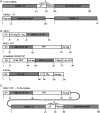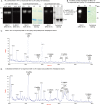Toward stable genetic engineering of human O-glycosylation in plants
- PMID: 22791304
- PMCID: PMC3440218
- DOI: 10.1104/pp.112.198200
Toward stable genetic engineering of human O-glycosylation in plants
Abstract
Glycosylation is the most abundant and complex posttranslational modification to be considered for recombinant production of therapeutic proteins. Mucin-type (N-acetylgalactosamine [GalNAc]-type) O-glycosylation is found in eumetazoan cells but absent in plants and yeast, making these cell types an obvious choice for de novo engineering of this O-glycosylation pathway. We previously showed that transient implementation of O-glycosylation capacity in plants requires introduction of the synthesis of the donor substrate UDP-GalNAc and one or more polypeptide GalNAc-transferases for incorporating GalNAc residues into proteins. Here, we have stably engineered O-glycosylation capacity in two plant cell systems, soil-grown Arabidopsis (Arabidopsis thaliana) and tobacco (Nicotiana tabacum) Bright Yellow-2 suspension culture cells. Efficient GalNAc O-glycosylation of two stably coexpressed substrate O-glycoproteins was obtained, but a high degree of proline hydroxylation and hydroxyproline-linked arabinosides, on a mucin (MUC1)-derived substrate, was also observed. Addition of the prolyl 4-hydroxylase inhibitor 2,2-dipyridyl, however, effectively suppressed proline hydroxylation and arabinosylation of MUC1 in Bright Yellow-2 cells. In summary, stably engineered mammalian type O-glycosylation was established in transgenic plants, demonstrating that plants may serve as host cells for the production of recombinant O-glycoproteins. However, the present stable implementation further strengthens the notion that elimination of endogenous posttranslational modifications may be needed for the production of protein therapeutics.
Figures






Similar articles
-
Engineering mammalian mucin-type O-glycosylation in plants.J Biol Chem. 2012 Apr 6;287(15):11911-23. doi: 10.1074/jbc.M111.312918. Epub 2012 Feb 14. J Biol Chem. 2012. PMID: 22334671 Free PMC article.
-
Engineering of N. benthamiana L. plants for production of N-acetylgalactosamine-glycosylated proteins--towards development of a plant-based platform for production of protein therapeutics with mucin type O-glycosylation.BMC Biotechnol. 2010 Aug 24;10:62. doi: 10.1186/1472-6750-10-62. BMC Biotechnol. 2010. PMID: 20735851 Free PMC article.
-
The O-Hyp glycosylation code in tobacco and Arabidopsis and a proposed role of Hyp-glycans in secretion.Phytochemistry. 2008 May;69(8):1631-40. doi: 10.1016/j.phytochem.2008.02.006. Epub 2008 Mar 25. Phytochemistry. 2008. PMID: 18367218
-
Diverse glycosylation of MUC1 and MUC2: potential significance in tumor immunity.J Biochem. 1999 Dec;126(6):975-85. doi: 10.1093/oxfordjournals.jbchem.a022565. J Biochem. 1999. PMID: 10578046 Review.
-
Proteolysis of recombinant proteins in bioengineered plant cells.Bioengineered. 2014 Jan-Feb;5(1):15-20. doi: 10.4161/bioe.25158. Epub 2013 May 29. Bioengineered. 2014. PMID: 23778319 Free PMC article. Review.
Cited by
-
Engineering of human-type O-glycosylation in Nicotiana benthamiana plants.Bioengineered. 2013 Jul-Aug;4(4):191-6. doi: 10.4161/bioe.22857. Epub 2012 Nov 12. Bioengineered. 2013. PMID: 23147167 Free PMC article.
-
Critical Evaluation of Strategies for the Production of Blood Coagulation Factors in Plant-Based Systems.Front Plant Sci. 2019 Mar 7;10:261. doi: 10.3389/fpls.2019.00261. eCollection 2019. Front Plant Sci. 2019. PMID: 30899272 Free PMC article. Review.
-
Glucuronylated core 1 glycans are required for precise localization of neuromuscular junctions and normal formation of basement membranes on Drosophila muscles.Dev Biol. 2018 Apr 15;436(2):108-124. doi: 10.1016/j.ydbio.2018.02.017. Epub 2018 Feb 27. Dev Biol. 2018. PMID: 29499182 Free PMC article.
-
Engineering of sialylated mucin-type O-glycosylation in plants.J Biol Chem. 2012 Oct 19;287(43):36518-26. doi: 10.1074/jbc.M112.402685. Epub 2012 Sep 4. J Biol Chem. 2012. PMID: 22948156 Free PMC article.
-
Direct imaging of glycans in Arabidopsis roots via click labeling of metabolically incorporated azido-monosaccharides.BMC Plant Biol. 2016 Oct 10;16(1):220. doi: 10.1186/s12870-016-0907-0. BMC Plant Biol. 2016. PMID: 27724898 Free PMC article.
References
-
- Altmann F. (2007) The role of protein glycosylation in allergy. Int Arch Allergy Immunol 142: 99–115 - PubMed
-
- Bennett EP, Hassan H, Mandel U, Mirgorodskaya E, Roepstorff P, Burchell J, Taylor-Papadimitriou J, Hollingsworth MA, Merkx G, van Kessel AG, et al. (1998) Cloning of a human UDP-N-acetyl-alpha-D-galactosamine:polypeptide N-acetylgalactosaminyltransferase that complements other GalNAc-transferases in complete O-glycosylation of the MUC1 tandem repeat. J Biol Chem 273: 30472–30481 - PubMed
Publication types
MeSH terms
Substances
LinkOut - more resources
Full Text Sources
Other Literature Sources
Research Materials
Miscellaneous

